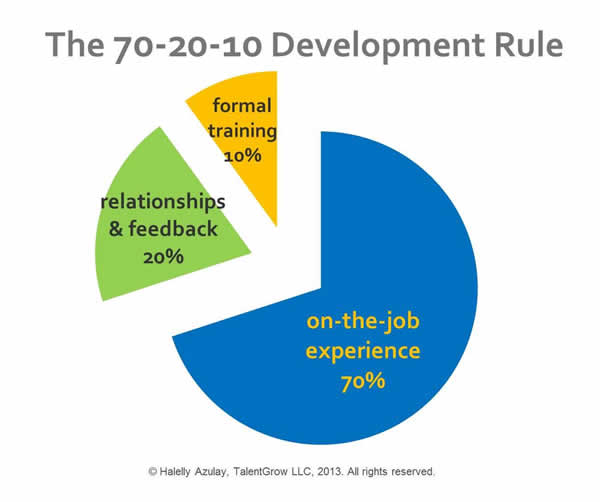ATD Blog
The 3 Most Vexing Employee Development Problems—and How to Overcome Them
Tue Dec 03 2013

Bookmark
Walk into any organization (of any type or size) and talk to its leaders about what keeps them up at night, and eventually some recurring refrains will emerge about the challenges of today’s workplace for creating appropriate and sufficient opportunities for employee growth and development.
In my work as a leadership and employee development consultant, facilitator, speaker and coach, this is my daily experience. In this post, I will describe the three most vexing employee development problems and suggest a way to overcome them.
Vexing Employee Development Problem #1: Limited Resources
“I am trying to figure out how to do more with less.” I hear this from almost every leader in every type of organization. Budgets and resources are tight.
Leaders, employees, and those who support them in HR and training are all trying to figure out how to create top performing organizations, satisfied customers, and happy shareholders or stakeholders in this new reality of constraint. They can’t afford to solve their performance problems by throwing money at them. More important, they can’t keep their top employees engaged and feeling developed by sending them to expensive training programs or providing them with unlimited online learning programs. What to do?
Vexing Employee Development Problem #2: Limited Time
The skill sets that supported their high performance yesterday may no longer sustain employees in the ever-shifting business environment of today and tomorrow. We need to support them by helping them proactively prepare for both today’s and tomorrow’s new challenges.
We also know that the literature on employee engagement points to the drive to grow and develop new skills as a key driver of engagement. How do we take time to support employees’ need for ongoing development while fulfilling the current demands of customers and stakeholders?
Even if we spend money and send them out to training, there is a significant opportunity cost: those employees are missed back at work, and their work either becomes backlogged or falls on their colleagues, who are themselves overextended. What to do?
Vexing Employee Development Problem #3: Training May Not Be the Most Effective Development or Learning Option
Learning experts tend to agree: Training is not always the best way to close a knowledge or skills gap. To be sure, event-based learning opportunities may create awareness or provide some practice opportunities.
However, even if we have the money and time to send employees to training or e-learning programs, many learning needs can be addressed more effectively or efficiently by other means that a one-time learning “event” cannot provide, such as recurring opportunities for observation, ongoing hands-on practice, or coaching and feedback from experts in the field on a just-in-time basis.
Frequently, even if training can help, it is not sufficient to close the skill gaps and newly acquired skills from training programs must be practiced and sustainably supported outside the classroom, over time. What to do?
Solution: Take Learning Outside the Classroom
Once we appropriately assess and define learning needs for each employee, we should not limit ourselves to searching in course catalogs for events to address these learning needs. If we think outside the box and stretch our imagination, we can actually come up with myriad other ideas for developing those employees with attention to their unique learning preferences, organizational budget, and time constraints—all while utilizing existing resources and opportunities.
Think about your own career: How much of what you know and do was learned in a classroom and how much was learned on-the-job? In the learning industry, we like to refer to the 70-20-10 rule: 70 percent of development happens via on-the-job experience, 20 percent through relationships and feedback, and 10 percent from formal training opportunities.

Even if those numbers are not exact (and there are those in our field who like to argue about their accuracy), the point is clear: employee development needs cannot, and should not, be fully addressed in formal training. What if we expanded our purview of employee development and applied creative thinking to the solutions we offer employees and leaders for their learning needs?
For example, we could support employee development through facilitating their engagement in volunteer opportunities that create intense and varied learning of competencies like leadership, project management, public speaking, or financial acumen. Or, we might involve employees in special teams that create opportunities to develop competencies like teamwork, organization, or even particular technical acumen.
The ideas are just as limitless as the opportunities to implement them—on a low budget and without great impact on time or other resources and without significant opportunity costs to the organization. Often, these types of development and learning opportunities actually create side-benefits that only add value to the organization.
Want to learn more about these and several other ideas for outside-the-classroom employee development on a tight budget? ASTD will be hosting an intensive, interactive workshop called Employee Development on a Shoestring, based on the top-selling book by the same title, which will help you explore non-training ways to develop employees on a tight budget. Attend this one-and-a-half-day event to consider the pros and cons of various non-training development methods, consider the requirements and specifications of multiple employee development methods, and begin to develop a strategy for “selling” and implementing new employee development methods in your (or your client’s) organization. Join us on March 13-14, 2014 in Washington, D.C.

